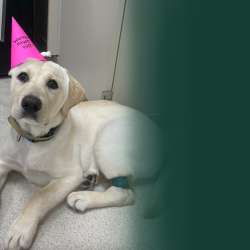History and Diagnosis

Dewey, an 8-month-old intact male Dalmatian, presented to the MSU Veterinary Medical Center’s Emergency Service after three days of lethargy and progressive hind-limb stiffness and pain. Previously, Dewey’s neighbors had sprayed pesticides, and when Dewey was playing outside, his owners saw him take some of the sprayed plants from their yard in his mouth; however, they did not believe he ingested them.
The next afternoon, Dewey became lethargic and his health continued to deteriorate through the night. He began shaking and his owners recorded a temperature of 104.4F.
His owners took Dewey to their veterinarian, who performed a CBC and biochemistry profile, which revealed a leukocytosis. Dewey was placed on cephalexin and given an injection of penicillin.
While the owners initially noted improvement, they decided to seek a second opinion the next day. A second veterinarian performed radiographs that were unremarkable and added sucralfate, tramadol, and carprofen to Dewey’s medication regimen. But the following day, Dewey’s owners discontinued this course of treatment.
At this point, Dewey was mobile, but experiencing increased pain and stiffness. His owners noticed that Dewey’s bowel movement was mucoid and greasy. That morning, Dewey was noted to have progressive weakness of the hind limbs. After he was administered a morphine injection and given a dose of baby aspirin, his owners brought him to the MSU Veterinary Medical Center.
Upon presentation to the Emergency Service, clinicians performed a physical examination, where they noted Dewey to be in sternal recumbency with a tense abdomen, the inability to stand without assistance, and a kyphotic posture.
A thorough neurologic examination was performed by Dr. Joshua Gehrke of the Neurology Service, which revealed that Dewey’s symptoms had progressed rapidly from initial presentation. Dewey was now noted to be tetraplegic and had a decreased withdrawal reflex in the right thoracic limb. These neurologic signs were consistent with a caudal cervical lesion localizing to the C6-T2 spinal cord segments.
Given the degree and progressive neurologic signs, an emergency MRI was performed. The MRI revealed large hematoma thought to be arising from the ventral spinal artery and the dura mater at the level of the seventh cervical vertebrae. The hematoma was so all-encompassing that it was noted to be causing compression from outside the spinal cord.
After some thought, the owners suspected the injury to be secondary to a possible traumatic event, as Dewey has been renowned for his intense Frisbee activity. It was hypothesized that the artery and dura mater ruptured during one of Dewey’s recent Frisbee encounters, thus causing Dewey’s clinical signs and pain.
Treatment and Outcome
Surgical intervention was discussed, but Dr. Gehrke decided not to pursue extensive spinal surgery. Given the degree and extensive nature of the hematoma, removal could potentially cause permanent paralysis. It was also possible that once the old hematoma was removed from the spinal cord, the Neurology team may not be able to control new arterial hemorrhaging, given the limited visual surgical field.
Dr. Gehrke decided to place Dewey in a custom-made external coaptation or “cervical splint.” The device was made in-Hospital by the Biomedical Engineering staff. It was placed around Dewey’s neck and thorax to immobilize his spine and provide stability and some pain relief during the healing process.
While in the hospital, Dewey began to slowly improve neurologically. Five days later, Dr. Gehrke determined that Dewey would be able to continue his care at home with careful monitoring. The Veterinary Medical Center provided Dewey’s owners with steps for at-home care and monitoring that included mobility assistance, bladder expression, physical therapy, hygiene, feeding, and the administration of pain medications.
One week later, Dewey returned to the Neurology Service for a check-up and bandage change. Dewey’s thoracic and pelvic limb joints showed improvement in flexing and extending with passive range of motion and massage. He also was able to support his own weight during the bandage change. Dr. Gehrke noted Dewey’s excellent progress and added weekly rehabilitation through the Veterinary Medical Center’s Rehabilitation Service to aid in his recovery.
Comments
Traumatic spinal cord injury (SCI) can have devastating effects on dogs, including paralysis and incontinence. Dewey’s condition was complicated, and once diagnosed, Dewey’s prognosis was guarded. Proper treatment provided by the Critical Care Team and the Neurology Service allowed Dewey to heal effectively at home with his family, and by working with the Rehabilitation Service, Dewey was able to make a full recovery.



